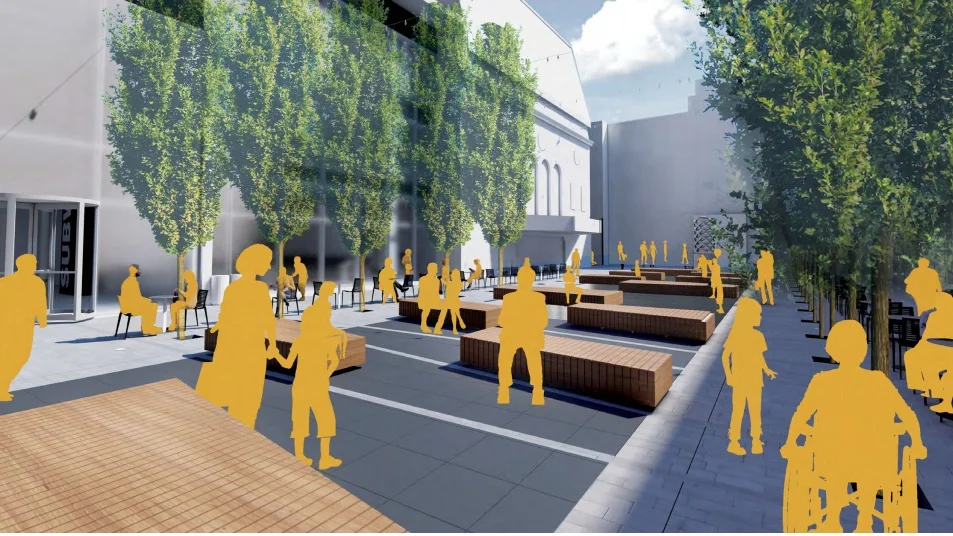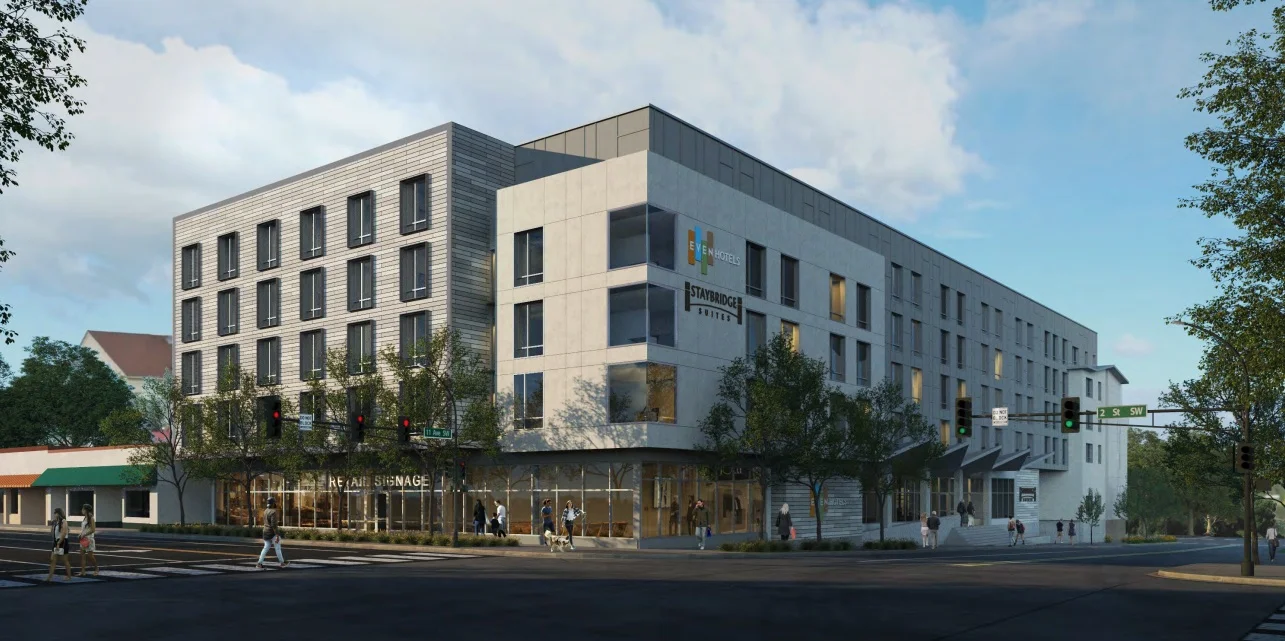Heart of the City design work reaches the homestretch
By all indications, 2019 will be the year Destination Medical Center’s Heart of the City plans begin to take on a pulse. Already, two key projects are under way in the sub-district — the interim renovation of the Chateau Theatre and the $26.5 million remodel of the Wells Fargo building.
That construction work comes as DMC and city officials continue to study, design and test ideas for the nearby public spaces. The design work for Heart of the City phase one is expected to wrap up by the end of the year. The area includes the east end of Peace Plaza along with First Avenue.
There have been a number of changes to the plans since the initial renderings were released — notably, the stairs leading to an elevated platform have been taken out. Water and art remain key focuses, and the design team has since modified their plans to include the Peace Fountain. They are now in the process of working with consultants and artists, both local and international, to solidify other concepts for enhancing the space.
The Peace Fountain by Charles Eugene Gagnon, 1989 / Med City Beat
For a full update on where plans stand today with the Heart of the City redesign, we talked with Patrick Seeb, director of economic development and placemaking for DMC, and Shane Coen, a consultant on the project and the founder of a Twin Cities-based landscape architecture firm. The entire interview is published below.
Heart of the City was one of the top priorities coming out of the development plan. I think some, though, are still unsure why changes are being discussed to begin with. Why is now the time to be considering such ambitious plans for the future of the space?
Seeb: There is a lot of evidence that public space can be a major driving of private investment. In fact, the entire DMC development plan and its six sub-districts are organized around the idea of a great public space at the heart of each sub-district. This is why we have been spending so much time on Peace Plaza, Discovery Walk, and the public realm of St. Marys Place, each of which are at a slightly different place in terms of design and implementation. Soon we will be taking up the Waterfront and UMR sub-districts more aggressively.
The ambitious plans for Peace Plaza reflect both role it plays in our community and the level of new investment happening around it, such as new retail, Chateau Theatre renovation, Wells Fargo building redevelopment, Kahler enhancements, and the expansion of the Gonda building.
Peace Plaza serves a variety of roles in the community. For patients, it can be a place of solace. For locals, it may be a place where they come for a rally or vigil. How do you balance those needs when developing plans for the space?
Seeb: We closely studied how Peace Plaza is being used by the community and recognized that the closer you were to Gonda the more it needed to serve as a place of solace but the further to the east, it could be a place for more activity and engagement. We absolutely believe the needs of local community and visitors can be met here.
There have been a few notable modifications from what was first pitched to the city. What did you learn along the way that led to the changes being made?
Seeb: By its very nature, design is an iterative process. Ideas are turned into forms and objects to convey a kind of functionality. When presented publicly, people tend to react positively or negatively to the objects. What’s really important, however, is to determine whether or not we got the functionality correct. What is that object supposed to accomplish?
There was some initial pushback regarding plans to potentially move the Peace Fountain out of the plaza. But, from what I understand, it is staying put now. What was the thinking there?
Seeb: Peace Fountain has been moved and modified several times during its life on Peace Plaza. We explored several different concepts, including relocating it to a park space outside of downtown. With the benefit of a great deal of community conversations, and significant time with the artist’s wife, Arlyn Gagnon, we are developing a very cool way of integrating the fountain with some additional water features that will be quite wonderful.
Shane Coen
Recently a team of artists, architects and local delegates met to discuss ways to enhance the space with art and engineering. What came out of those discussions?
Coen: One of the 12 Heart of the City Principles creating with the community is “Make it Art.” In response, the DMC, City and design team have worked together on promoting a collection of world-renowned and locally-recognized artists and thinkers to collaborate on a series of art installations and communication strategies to activate peace plaza and make it a one of a kind community space that brings the community together regularly. The Public Art Curatorial Division within El dorado Architects is part of the design team. This collaboration and work is unique and they have been working closely with our entire team to bring forth the recommendations for the phase one art and communication installations.
The Chateau renovations have led to an early focus on the east end of the plaza. Can you tell us about what's being planned for that area and when we may begin seeing plans in motion?
Seeb: Initial renovations of Chateau Theatre will be complete by mid-summer and the venue will be ready of use. Additionally, improvements to the Wells Fargo building have already begun. When that project is complete there will be a new, much more transparent façade, and a new entrance onto Peace Plaza. Moka will be opening in the spring, serving not only coffee but wine and beer as well.
More and more, we have been hearing "Embrace the North." But beyond SocialICE, the area isn't exactly alive during the winter. What is being discussed to make this a year-round destination?
Seeb: Winter cities around the world are looking for ways to activate their public spaces year ‘round. Events like SocialICE, AirGlow, Here Comes Santa, and the fall prototyping initiative are examples here. In addition to special programming, we are looking for infrastructure improvements that make space more inviting throughout the year, such as heated seating, snow and ice melt systems, dramatic lighting, and seasonal art installations. Or perhaps a winter version of Games on the Grass.
Finally, the businesses surrounding public spaces play an important role. Outdoor dining in the shoulder seasons, such as late fall and early spring are quite common in some communities, supported by space heaters or warm blankets.
I know versatility has been a theme in the planning process. What does that look like? How can the Heart of the City be transformed to respond to the weather and meet the needs of the space?
Coen: We have recently tested heated benches during SocialICE and as you can imagine, the public loved the idea. Also, during that event, we interviewed participants on the topics of weather mitigation and the most recommended strategy was wind mitigation. The design and engineering team, DMC and City are exploring how to incorporate warming and wind mitigation strategies. In addition to lengthening the time the public will use these improved outdoor spaces as the weather cools, we are also exploring how the spaces can be designed to offer flexibility to accommodate many different types of events. Moveable furniture over fixed seating is being carefully study within Peace Plaza and we are encouraged with our findings thus far.
Patrick Seeb
As part of the planning, a team of locals — myself included — have been brought in to continue projects that were first developed for the 2016 PlaceMakers community prototyping event. How have those efforts tied into the current vision for the space?
Seeb: The 2016 PlaceMakers event was set up as a stand-alone initiative… to get our community thinking about how to build our city with health in mind. We were so pleased that the Coen team saw value in that work, and reached out to four of the prototyper teams to explore whether or not their ideas could be further developed and contribute to the thinking of the Peace Plaza final design. Like all design, this will be an iterative process. Some may end up on the cutting room floor. Others may look very different than originally conceived.
What's next? In other words, when may we start seeing tangible changes in the Heart of the City, both in terms of construction and programming?
Seeb: Nearly all of 2019 is dedicated to the final design and construction documents for Heart of the City, including a series of community engagement and public events. Reconstruction is slated for 2020.
I would like to add, that perhaps one of the most dramatic changes is how 1st Avenue will be reconstructed. The current, rather wide street, will be replaced with a much more pedestrian friendly, tree covered corridor. This alone will significantly increase the amount of public space and greenery in the downtown core.
Disclosure: Med City Beat publisher Sean Baker represents one of four local teams whose prototyping work has been funded by DMC and others to be potentially included in the Heart of the City. This work is separate from Med City Beat, and we were not compensated to produce this article.











